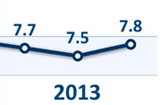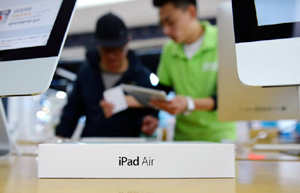Bridging the digital divide
Updated: 2013-09-22 14:39Yes, we are learning and a big part of our business is the data we generate. Every time we come into a city we are learning from the culture of the citizens and the behavior of the people. We are able to help municipalities make decisions with that data. Of course, we are very keen to protect the privacy of people. We are compliant with the strictest protections of privacy. What we have observed is, for example, users in the Philippines are texting each other in the same room. When we were searching for each other earlier we called on the phone, but there they are using text messaging. Why? Because, it is too expensive to call. Or, in Buenos Aires, people do not use their sophisticated smartphones in the street because of theft.
In my industry we say that there is before the iPhone and after the iPhone. It's like before Jesus Christ and after Jesus Christ. And, we're only at the tip of the iceberg. We have human-to-human Internet devices like the iPhone and Skype, and YouTube—and now, we have machine-to-machine Internet communications. It's part of those "smart city" services that we are investing in. There will be more than 50 billion machines connected to the Internet by the year 2020. We are acting as the facilitator for that.
How important are partnerships when you are moving into emerging markets? You have an agreement with China Railway Signal & Communication Shanghai Engineering Bureau Group Co. Ltd. (CRSCS) to provide WiFi on high-speed rail. What else are you developing?
For us, it is a requirement to have partners like CRSCS. We now have a new agreement with [Chinese telecommunications company] ZTE. They are the second largest such company in China after Huawei Technologies. On September 12 we announced an agreement with Guangdong Eastern Fibernet Co. Ltd., a business-to-business carrier for companies and government institutions. The agreement promises to create one of the main wireless providers in Guangdong Province. The alliance with Eastern Fibernet will help us to increase the speed with which we reach agreements with Chinese local administrations, an important part of GOWEX's worldwide leadership strategy, and will help us achieve our target of reaching 300 cities around the world.
Partnerships are essential for us in China. Not only because of the rules of doing business in China but also because of the knowledge of the culture and the behaviors of consumers. We are not putting Spanish people in our offices around the world; we are putting Spanish people and local people as much as possible. Usually our country managers are local people.
We are also moving into Ningbo [of Zhejiang Province], the second largest port city in China with more than 10 million inhabitants. We're signing a very important agreement to make Ningbo a "smart city."
We have hired Margaret Chen as vice president for Asia, and, as you know, she is one of the most experienced and savvy experts in the Chinese telecommunications market. We made a good acquisition. We are trying to enlarge our staff with senior people from local markets. China is a very important market for us, we are forecasting that it will be around 30 percent of revenues overall and more than 50 percent of our revenue from emerging markets.
Are there synergies between Spanish and Chinese companies and consumers?
There are many clear advantages for Chinese companies to do business with the Spanish people. We are the gateway to Latin America. And, we are a gateway for Chinese investors into Europe because our assets are undervalued. You can go into Spain and buy buildings and buy into industries at a fraction of the value of the business itself. I'm talking about real estate, industry, and many opportunities for Chinese investors to get into Europe that is cheaper than going into Germany, for example.
The economic opportunity for Spanish companies is clearly the size of the Chinese market. It is promising even though it may be overhyped—growth is cooling down and you have to be rational in making decisions. China has 1.3 billion inhabitants but you can sell only to a fraction of the population right now. However, the potential of growth is such that you have to invest now for tomorrow.
Then there is the opportunity for cultural exchange. The culture of Spain is very attractive to China. Spain has the opportunity to provide innovation and creativity to China. We are very advanced in creativity and novel thinking. There is a lot of opportunity for tourism. In gastronomy, wine and leisure—Spain leads the world.























